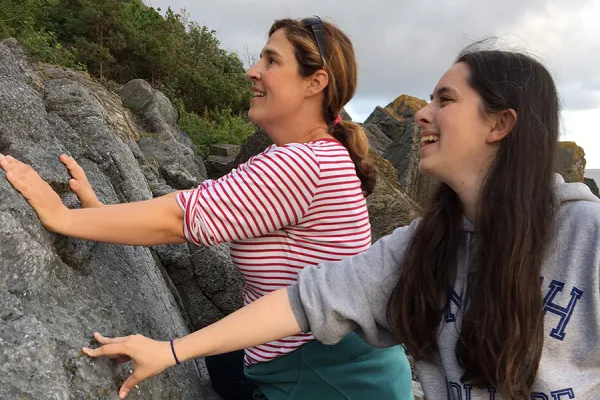Evolutionary ‘Sweet Spot’: Study by Prof. Pruss Helps Explain Unusual Fossils
Research & Inquiry

Published July 25, 2016
In a paper published last month in the journal Geology, Sara Pruss and colleagues at the Massachusetts Institute of Technology (MIT) identify mechanisms that help explain the presence of unusual fossils in earth’s geologic record.
Their work combines lab-based experiments with knowledge of earth history to advance scientific understanding.
Pruss, who is associate professor of geosciences at Smith, brought her scholarship in earth history to lab experiments aimed at discovering why microbes and microbial textures were preserved on the surface of sandstones and siltstones that date back 570 million years.
The results reveal what Pruss calls a “sweet spot in evolutionary history,” when numerous soft-bodied fossils were preserved in unusual ways on the seafloor.
Here’s what else Pruss had to say about her latest research:
Your study explores unusual fossils from a particular point in earth’s early history.
Pruss: “There was a moment in time in the Ediacaran Period, around 570 million years ago, when unusual animals and microbial textures appeared abundantly around the world. In this work, we explore the preservation of microbial fossils from that period that are preserved in coarse-grained sediment in marine environments. Paleontologists know that fossil preservation—particularly of soft critters—tends to be better in quiet water environments. Yet, these fossils were formed in coarse-grained, higher energy environments. The question my partners in the lab were asking was, ‘How could this happen?’ They designed experiments where cyanobacteria (microbes) were subjected to different conditions to try and identify the mechanisms that helped preserve these fossils.”
What does the presence of so many unusual fossils reveal about the Ediacaran?
Pruss: “The sediment these fossils were preserved in doesn’t show a lot of mixing by the organisms that lived there. In the Ediacaran, worms and other animals didn’t yet have that ability to mix the sediment abundantly. These fossils preserve very fine-scale microbial textures in the rocks. They’re small—on the order of a millimeter to centimeter scale. Their presence shows that there is a sweet spot in evolutionary history where these structures could be preserved—even in these unexpected settings—without disturbance from animals.”
How did you become interested in this topic?
Pruss: “Tanja Bosak at MIT, one of the co-authors of our paper in Geology, is a colleague I’ve worked with many times in the past. (I am a Ph.D. committee member for the lead author on this study, Sharon Newman of MIT, and one of our recent alumnae, Kelsey Moore ’15, is now a Ph.D. student in Tanja’s lab.) The kind of work that Tanja and her students do creates controlled lab experiments to understand processes involved in earth’s evolution. I bring knowledge of earth history and the rock record to those efforts. The combination is what makes this work so powerful.”
How does your new research help advance the field?
Pruss: “In the MIT lab experiments, Sharon observed mineral coatings on cyanobacteria in a matter of days; it was a rapid process. By marrying lab work and earth history, we were able to gain a mechanistic understanding of what was going on in the Ediacaran when these fossils were preserved. Our study also allows us to start asking important questions about other intervals in earth’s history.”
What will you do as a followup to your study in Geology?
Pruss: “We are working on publishing a second paper that uses the same type of analysis. There are more questions we can answer by better understanding and constraining these fossil-preserving mechanisms. I want to understand more about the transition from the time when we start to see the first large animals on earth to the period when that complexity gets more pronounced. I will be going back to Namibia in September to study units of similar ages, and my students at Smith are also going to be involved in exploring some of these questions. There will be more free flow between my lab and the lab at MIT.”
Associate Professor of Geosciences Sara Pruss and Emma Roth ’17 exploring a rock face in Norway.